#the wakhan front
Text
just a poll to get a feel for interest
asking bc i have a few things for swann in the drafts, but i wanna see if there’s even any interest in that in the first place
#✭₊˚✧ jen .#swann arlaud#anatomy of a fall#vincent renzi#anatomie d'une chute#anatomy of a fall vincent#the bare necessity#ni le ciel ni la terre#neither heaven nor earth#the wakhan front#bloody milk#grace a dieu#the assembly line#l’etabli#poll
11 notes
·
View notes
Photo

Ni le ciel ni la terre (The Wakhan Front)
2015. Fantasy War Thriller
By Clément Cogitore
Starring: Jérémie Renier, Kévin Azaïs, Swann Arlaud, Marc Robert, Finnegan Oldfield, Clément Bresson, Sâm Mirhosseini, Christophe Tek, Steve Tientcheu, Patrick Ligardes, Michaël Vander-Meiren...
Country: France, Belgium
Language: French, Persian
#Ni le ciel ni la terre#Clément Cogitore#The Wakhan Front#Jérémie Renier#Kévin Azaïs#Swann Arlaud#Marc Robert#Finnegan Oldfield#Clément Bresson#Sâm Mirhosseini#Christophe Tek#Steve Tientcheu#Patrick Ligardes#Michaël Vander-Meiren#France#Belgium#French#persian#2015#Fantasy#War#Thriller
2 notes
·
View notes
Photo


Ni le ciel ni la terre, dir. Clement Cogitore, France, 2015
6 notes
·
View notes
Photo

Wakhi nomad boy eating bread in front of his yurt, Big pamir, Wakhan, Badakhshan, Afghanistan. Taken on August 12, 2016.
PayPal Donation: [email protected]
#Eric Lafforgue#Wakhi#Wakhi Nomad#eating#bread#yurt#Pamir#Big Pamir#Wakhan#Wakhan Corridor#Badakhshan#Afghanistan#2016
164 notes
·
View notes
Text
Woman Photographer travelled around the world to see how is defined beauty in 37 countries
Mihaela Noroc, a 23 year old Romanian, left her job to travel around the world. She explored all continents except Antártida.
Since 2013, Mihaela Noroc has photographed over 2,000 women in more than 50 countries, listening to their stories and learning about their lives.
For Noroc, beauty is diversity. She believes each one of the “shining stars” in her book radiates dignity, strength and beauty.
We live in a world where female beauty standards vary but are all socially and culturally constructed. The Romanian photographer Mihaela Noroc traveled the world with her camera and backpack, photographing women in their everyday surroundings and listening to their stories. The result is the “Atlas of Beauty.”

Since 2013, Noroc has photographed over 2,000 women in more than 50 countries, listening to their stories and learning about their lives.
“I noticed that there is a lot of pressure on women to look and behave a certain way,” she told Arab News.
“In some environments, it’s the pressure to look attractive. In others, on the contrary, it’s the pressure to look modest. But every woman should be free to explore her own beauty without feeling any pressure from marketing campaigns, trends or social norms.”
For Noroc, beauty is diversity. She believes each one of the “shining stars” in her book radiates dignity, strength and beauty.
During her five-year odyssey, there have been tremendous ups and downs. Yet, with each country, Noroc never failed to tell the story of the woman in her photographs. Some countries were deemed dangerous — but she traveled there anyway.
“In Afghanistan, I traveled in a remote area called Wakhan Corridor. The fighting was very close, condemning this place to total isolation,” she said. “People were living like their ancestors lived hundreds of years ago, so photography was a miracle for them. They were incredibly happy to see themselves in photos and I was invited to every home to photograph each member of the family.”
Visiting North Korea, Noroc was accompanied by local guides as she walked the streets to get a glimpse of women in their daily routines as if nothing was out of the norm.
“There is a lot of pressure on women to look a certain way, so sometimes it’s a struggle to be yourself, to make yourself accepted as you are. But I hope this project will encourage more women and men to follow their own path, to explore their own beauty without feeling constrained.”
Traveling as a backpacker introduced Noroc to all kinds of environments. She has captured beauty in Brazilian favelas, in an Iranian mosque, on the Tibetan plateau, in the Kurdistan region of Iraq, the Amazon rainforest, upscale neighborhoods of Paris, downtown New York and more.
She focuses on photographing the environment around the women, and prefers to photograph their natural faces, without a lot of makeup.
“Many of the women I photograph are in front of a professional camera for the first time. This isn’t bad at all because they are more authentic. For even more authenticity, I always use natural light. Through my camera, I try to dive into their eyes and explore what’s inside.”
Each image is raw, colorful, delicate, intimate, striking and empowering. A Jordanian Bedouin grandmother sits with her children and grandchildren in the background, the woman’s deep wrinkles revealing her desert life living off the land.
Another image shows the resilience in the striking green eyes of a Syrian refugee with her two daughters in a camp in Greece. In Jodhpur, India, a young woman heads to the market in a vibrant fuchsia outfit and silver jewelry.
“There is much love, beauty and compassion in the world and I see it with my own eyes. Yet a few sources of hate and intolerance can ruin all this. Many times, the victims of intolerance are women, and while on the road, I hear many heartbreaking stories.” I say that the courage of women has no end, and that's part of their beauty...
MICHAELA NOROC
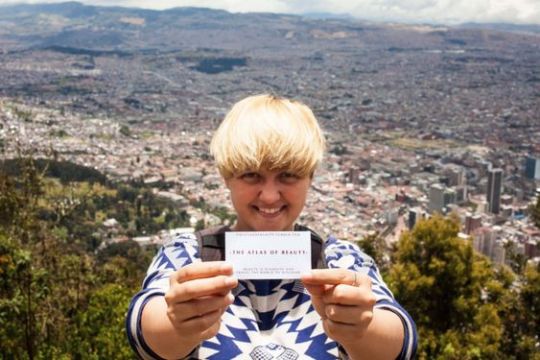
2 notes
·
View notes
Photo

https://www.gruhkhoj.com/padmavati-constructions/padmavati-river-front New NA Plots for sale in Karad Wakhan Road Area Padmavati River Front #Project by Padmavati Construction F.S.I. 1.4 app on Pro-data basis Hanging bridge for stunning experience (at Karad City) https://www.instagram.com/p/CJV1JMjL3BT/?igshid=gfde27qsda16
0 notes
Photo

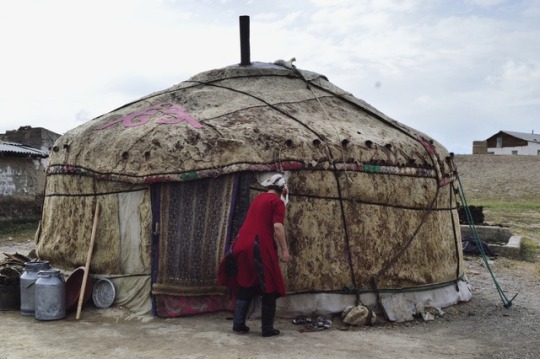
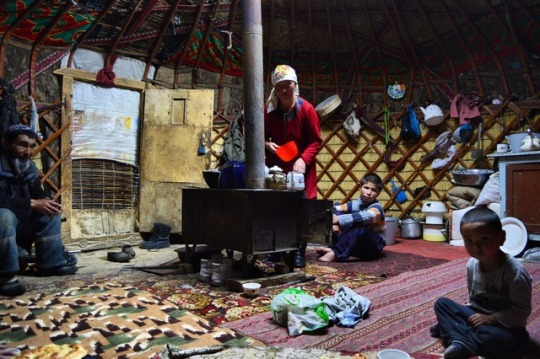







An extract from one of my stories about a Nomadic family of the Pamir Highway Tajikistan: I met this family on the Pamir highway in Tajikistan. They lived way way out deep in the mountains. The Pamir itself - known as route M-41 (the second highest highway on the planet) - reaching up to 4655m lies along the border of Afghanistan separated only by a river. The road was a major route and link within the Silk Road. The traditional Pamir begins in Afghanistan - Mazar-i-sharif - and stretches through Uzbekistan, the entirety of Tajikistan, all the way through to Osh in Kyrgyzstan. I actually hitchhiked the route in its entirety. Through the greater section of Tajikistan I hitched with travelers I'd met in the Tajik capital in their car. The Tajik family we discovered somewhere near to the subsection of Tajikistan which borders China, a slither of Afghanistan -behind which is Pakistan- and only 200km as the crow flies from Delhi, India. The Wakhan Valley.. Immediately we were invited in. Taking off our shoes, their home was warm and homely inside. Carpets of animal skins and a fire over in the center. Tea was immediately warmed for us. In the beautiful hospitality of Eastern cultures homemade bread was laid out in front of us, butter from the milk of their animals and tea. The mother watched with waiting eyes for us to finish our bowls of tea immediately to take them and refill them, each time giving and receiving with eye contact and one arm placed on her elbow as a sign of respect. Nomadic families of the Pamir Highway Tajikistan Read the FULL STORY and help support my journey on https://www.patreon.com/CassiaChloe New story releasing the first of every month of human beings who Inspire me. From every corner of the globe; from nomads, to homes, to homeless, to travelers, to mothers and ladies of the night. Inspiration is found in every corner of existence. Inspiration (inspire- from route respire) breathes life in to me and keeps me on the road.
#travel#Patreon#traveler#Tajikistan#travel story#inspiration#amazing humans#humanity#cassia Chloe#explore more#nomad#nomadic#central Asia#travel central Asia#travel Tajikistan#Pamir highway#Pamirs
19 notes
·
View notes
Photo
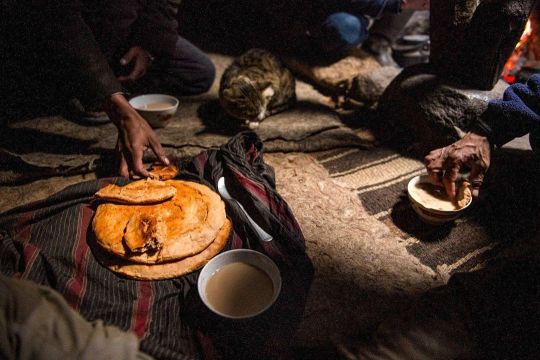
Evening Tea Bread and milk tea are offered to any traveler coming to a camp. A small tablecloth quickly opened on the ground, bread thrown when the tea is cooked. Hands tend to the loaves, one silently breaks the loaves and distributes them in front of each sitting men. Cups are filled, passed hand by hand in the order of ancestry or foreignness. Cats can then get their share too. #Afghanistan #meal #tea #bread #companionship #Pamir #Wakhan #everydayafghanistan #photography #hospitality #etiquette #journeying (at Vakhan, Afghanistan) https://www.instagram.com/p/CBwPLfzB1J-/?igshid=8m6xb4aju16f
#afghanistan#meal#tea#bread#companionship#pamir#wakhan#everydayafghanistan#photography#hospitality#etiquette#journeying
0 notes
Photo
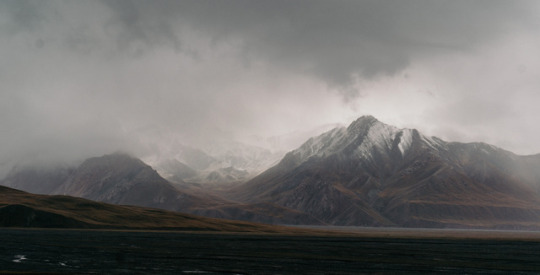

After a hell of a night in no man’s land between Tajikistan and Kyrgyzstan I wake up to the rain streaming down the fly unabated. Inside the tent everything’s damp with wet clothing draped from the sealing in a futile attempt to dry. You know it’s gonna be a great day when you get to put on yesterday’s cold, moist outfit again. After a breakfast shake I pack up and set off into the thick mist and drizzle to the Kyrgyz border, accompanied by the Kinetic Nomads. The muddy track is beyond terrible, as neither country feels responsible to maintain this stateless 15km stretch. But when the fog clears a bit, I find myself cycling through a postcard straight from Iceland.
The Kyrgyz border crossing also marks the boundary between artisanal bookkeeping and the digital age, with a guard behind an actual computer scanning my passport. Outside the small customs booth the rain is coming down in monsoon strength again, so we ask permission to wait it out inside. But while standing there I’m literally swept of my feet by a wave of heavy nausea. I just sort of collapse in a corner of the booth, feeling like I’m about to pass out any second. Maybe half an hour later I’m able to get back on my feet, but I know I need to get somewhere warm and dry, quickly. There is no other option than to get biking again.
The closest village, Sary Tash, is around 35k’s away. As I’ve heard of a guesthouse there, I decide to go for it in one big push, putting all my focus to the road. Survival mode really. The last 15 k’s I’m able to see the village in the distance -almost touch it- at the end of the straight asphalt line cutting through the Kyrgyz steppe. But the free roaming headwind keeps it dangling in front of me for over an hour. With my last strength I make it to the homestay, drop my bike against the wall and hobble through the front door to crash on a bunch of pillows.
Muras guesthouse is arguably the best place to fall sick in Central Asia. The sister-run homestay is the newest, cleanest place I’ve seen along the entire Pamir Highway, with as crown jewels a hot shower and indoor toilet. An oasis. The medicine I bought in the Wakhan Valley now comes in great to keep in essential nutrients to recover, but still I‘m felled for three days with zero energy and the worst ‘stomach problems’ you have never encountered.
In no way am I physically ready to get back on the bike again after my three day break, but I must hit the road to make my flight home. Some other guests kindly offer me a ride for the remaining stretch, but I don’t think I would ever forgive myself for copping out this close to the finish line. I want to end this adventure the way I feel it should: by myself, on a bike, reaching my limits.
Only 185 kilometres and two more mountain passes stand between me and holding my wife. It’s basically a real life version of the final level in Donkey Kong…
The first pass right outside town is a punch in the gut, forcing a heavily recovering body back into beastmode. But once you get back into that cadence of suffering, I’m surprised how quickly it adjusts. At the end of the second day I make it to the foot of the last big pass. A rainstorm is cooking and heavy gusts of wind in combination with the gradient make cycling nearly impossible at times. But the gnarly conditions only fuel my desperation and anger driving me up the mountain, be it tantalizingly slowly. Halfway up night has fallen, and I realize I can’t make it all the way today. So I squat a half open shed by the side of the road to set up my tent inside.
It must be around two or three at night when an old Russian truck pulls over right outside my bivouac and lets its ear deafening engine run no-load to cool down from the strenuous climb. Wide awake, I hear the intoxicated driver stumbling and spluttering around the property. Thankfully he doesn’t spot my tent in the shed, where I’m sitting up straight with my headlight and pocket knife handy…
#pamirhighway#Pamir#tajikistan#kyrgyzstan#cycling#adventure#outdoors#camping#mountains#wilderness#adventurecycling#adventurebybike#bicycletouring#bikepacking#beastmode#sonyalpha#nex6#gopro#worldbybike#panniercc#celebratewild#freedom#desolation#solotravel#travelsolo#travel#snelfietsen#photography#portrait
6 notes
·
View notes
Text
Gilgit–Baltistan
Gilgit–Baltistan (Urdu: گلگت بلتستان, Balti: གིལྒིཏ་བལྟིསྟན, formerly known as the Northern Areas[4]) is the northernmost administrative territory of Pakistan.[5] It borders the administrative territory of Azad Kashmir to the south, the province of Khyber Pakhtunkhwa to the west, the Wakhan Corridor of Afghanistan to the north, the Xinjiang autonomous region of China to the east and northeast and the Indian-administered state of Jammu and Kashmir to the southeast.
Together with Azad Kashmir, it forms part of the disputed Kashmir region, which has been the subject of conflict between India and Pakistan since the two countries' independence and partition in 1947.[6][5]
Gilgit–Baltistan is an autonomous self-governing region that was established as a single administrative unit in 1970, formed by the amalgamation of the Gilgit Agency, the Baltistan region and the former princely states of Hunza and Nagar. It covers an area of 72,971 km² (28,174 mi²) and is highly mountainous. It has an estimated population approaching 1,000,000. Its capital city is Gilgit (population 216,760).
History
The territory was part of the Delhi Sultanate until it fell to the Mughal Empire in the early half of the 16th century. By 1757, suzerainty of the region was obtained from the Mughals by Ahmad Shah Durrani under an agreement[7] and became part of Afghanistan[8] (also known as the Durrani Empire)[9][10][11] until Ranjit Singh invaded and took control from the Afghans in 1819.[12] It became a princely state with the name "Jammu and Kashmir" around 1847. After the partition of British India in 1947, Jammu and Kashmir initially remained an independent state. After the Indo-Pakistani War of 1947, Pakistani control was established on territories captured by Pakistan to the north and west of the cease-fire line. In 1970, the name "Northern Areas" (today's Gilgit–Baltistan, 72,971 km²) was applied to the areas that had previously been known as the Gilgit Agency and Baltistan. The name "Northern Areas" was actually first used by the United Nations to refer to the northern areas of Kashmir. A small part of the Northern Areas, the Shaksgam tract, was provisionally ceded by Pakistan to China in 1963.
Autonomous status and present-day Gilgit-Baltistan
The territory of present-day Gilgit–Baltistan became a separate administrative unit in 1970 under the name Northern Areas, formed by the amalgamation of the Gilgit Agency, the Baltistan District of the Ladakh Wazarat, and the states of Hunza and Nagar. It presently consists of seven districts, has a population approaching one million, and an area of approximately 28,000 square miles (73,000 km2), and shares borders with Pakistan, China, Afghanistan, and India.
While ruled by Pakistan since 1947, it had never been formally integrated into the Pakistani state and does not participate in Pakistan's constitutional political affairs until 2009.[13][14] On 29 August 2009, the Gilgit-Baltistan Empowerment and Self-Governance Order, 2009, was passed by the Pakistani cabinet and later signed by the President of Pakistan. The order granted self-rule to the people of Gilgit-Baltistan, by creating, among other things, an elected Gilgit-Baltistan Legislative Assembly. Gilgit–Baltistan thus gained de facto province-like status without constitutionally being a province.[13][15] Officially, Pakistan has rejected Gilgit–Baltistani calls for further integration on the grounds that it would prejudice its international obligations over the Kashmir dispute. Some militant Kashmiri nationalist groups, such as the Jammu and Kashmir Liberation Front, claim Gilgit–Baltistan as a part of a future independent Kashmir rather than as a future integral part of Pakistan.[16]
On September 29, 2009, the Pakistani prime minister, while addressing a huge gathering in Gilgit–Baltistan, announced a multi-billion-rupee development package aimed at the socio-economic uplifting of the people of the area. Development projects are slated to include the areas of education, health, agriculture, tourism, and the basic needs of life.[17][18]
An attempt in 1993 by the High Court of Azad Jammu and Kashmir to annex Gilgit–Baltistan was quashed by the Supreme Court of Pakistan, after protests by the predominantly Shia population of Gilgit–Baltistan, who feared domination by the Sunni Kashmiris.[16]
#Xinjiang#Pakistan#Khyber Pakhtunkhwa#Kashmir#Gilgit–Baltistan#Gilgit Agency#Durrani Empire#Baltistan
0 notes
Text
‘Atlas of Beauty’: A Romanian photographer captures images of female beauty that defy every stereotype

Since 2013, Mihaela Noroc has photographed over 2,000 women in more than 50 countries, listening to their stories and learning about their lives.
For Noroc, beauty is diversity. She believes each one of the “shining stars” in her book radiates dignity, strength and beauty.
“I noticed that there is a lot of pressure on women to look and behave a certain way,” she told Arab News.
“In some environments, it’s the pressure to look attractive. In others, on the contrary, it’s the pressure to look modest. But every woman should be free to explore her own beauty without feeling any pressure from marketing campaigns, trends or social norms.”
For Noroc, beauty is diversity. She believes each one of the “shining stars” in her book radiates dignity, strength and beauty.
During her five-year odyssey, there have been tremendous ups and downs. Yet, with each country, Noroc never failed to tell the story of the woman in her photographs. Some countries were deemed dangerous — but she traveled there anyway.
“In Afghanistan, I traveled in a remote area called Wakhan Corridor. The fighting was very close, condemning this place to total isolation,” she said. “People were living like their ancestors lived hundreds of years ago, so photography was a miracle for them. They were incredibly happy to see themselves in photos and I was invited to every home to photograph each member of the family.”
Visiting North Korea, Noroc was accompanied by local guides as she walked the streets to get a glimpse of women in their daily routines as if nothing was out of the norm.
“There is a lot of pressure on women to look a certain way, so sometimes it’s a struggle to be yourself, to make yourself accepted as you are. But I hope this project will encourage more women and men to follow their own path, to explore their own beauty without feeling constrained.”
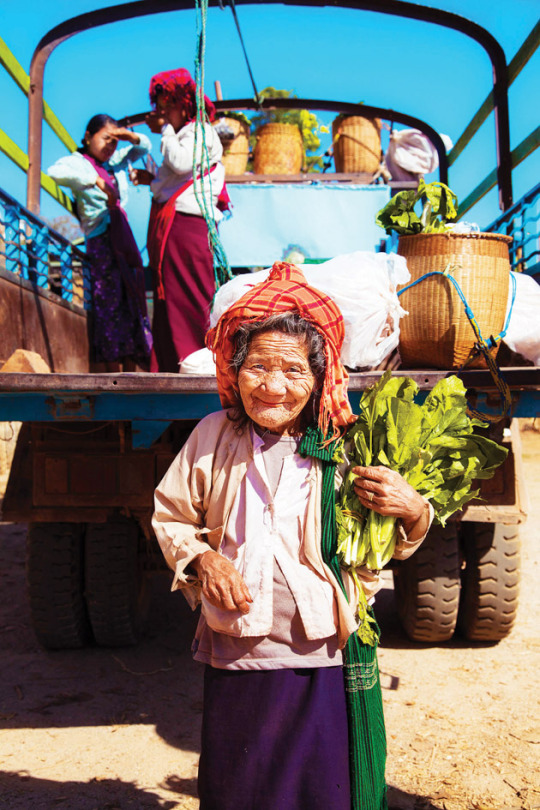
Traveling as a backpacker introduced Noroc to all kinds of environments. She has captured beauty in Brazilian favelas, in an Iranian mosque, on the Tibetan plateau, in the Kurdistan region of Iraq, the Amazon rainforest, upscale neighborhoods of Paris, downtown New York and more.
She focuses on photographing the environment around the women, and prefers to photograph their natural faces, without a lot of makeup.
Noroc also makes sure that she chats with her subjects while the photographs are being taken — she is an excellent conversationalist.
“Many of the women I photograph are in front of a professional camera for the first time. This isn’t bad at all because they are more authentic. For even more authenticity, I always use natural light. Through my camera, I try to dive into their eyes and explore what’s inside.”Each image is raw, colorful, delicate, intimate, striking and empowering. A Jordanian Bedouin grandmother sits with her children and grandchildren in the background, the woman’s deep wrinkles revealing her desert life living off the land.Another image shows the resilience in the striking green eyes of a Syrian refugee with her two daughters in a camp in Greece. In Jodhpur, India, a young woman heads to the market in a vibrant fuchsia outfit and silver jewelry.“There is much love, beauty and compassion in the world and I see it with my own eyes. Yet a few sources of hate and intolerance can ruin all this. Many times, the victims of intolerance are women, and while on the road, I hear many heartbreaking stories,” she said.Gauri, an Indian from Kolkata, India, sells splendid flower garlands at a Hindu temple. Female “bomberas” (firewomen) in Mexico City. Sisters Olga and Anya, street performers from Odessa, Ukraine. Eleonora, a ballerina from St. Petersburg, at one of the most prestigious dance schools in the world. A Mayan descendant in Guatemala donning a colorful dress and posing in her village. These are just some of the stories in the “Atlas of Beauty,” yet the journey is continuing since there are no limits to beauty in this world.“For me, beauty is diversity and it can teach us to be more tolerant. We are all very different, but through this project, I want to show that we are all part of the same family. We should create paths between us, not boundaries,” said Noroc.
Source: Arabnews.com | Photographs (c)mihaela noroc
https://www.tumblr.com/blog/view/photo-art-lady
2 notes
·
View notes
Photo

#Wakhan Corridor, #Afghanistan. Children attend a government school in Sust, while a new CAI school is going up next door to feed the need for more classrooms. One class is temporarily studying in a tent in front of the government school. Photo by Ellen Jaskol.⠀ ⠀ .⠀ #peacethrougheducation #educateagirlchangetheworld #scholarshipstudents #forHER #globalgoals #62million #girlpower #photooftheday #peace #picoftheday #moment #capture #instagood #girl #school #students #studytime http://ift.tt/2j5d5GL
2 notes
·
View notes
Photo

https://www.gruhkhoj.com/padmavati-constructions/padmavati-river-front New NA Plots for sale in Karad Wakhan Road Area Padmavati River Front #Project by Padmavati Construction F.S.I. 1.4 app on Pro-data basis Hanging bridge for stunning experience. (at Karad City) https://www.instagram.com/p/CI5k-1wr7yk/?igshid=tp0ti5jhj3u
0 notes